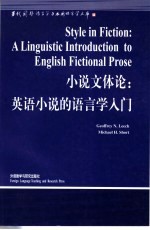图书介绍
小说文体论 英语小说的语言学入门 英文版PDF|Epub|txt|kindle电子书版本网盘下载

- GeoffreyN.Leech,MichaelH.Short著申丹导读 著
- 出版社: 北京:外语教学与研究出版社
- ISBN:7560023827
- 出版时间:2001
- 标注页数:411页
- 文件大小:17MB
- 文件页数:449页
- 主题词:
PDF下载
下载说明
小说文体论 英语小说的语言学入门 英文版PDF格式电子书版下载
下载的文件为RAR压缩包。需要使用解压软件进行解压得到PDF格式图书。建议使用BT下载工具Free Download Manager进行下载,简称FDM(免费,没有广告,支持多平台)。本站资源全部打包为BT种子。所以需要使用专业的BT下载软件进行下载。如BitComet qBittorrent uTorrent等BT下载工具。迅雷目前由于本站不是热门资源。不推荐使用!后期资源热门了。安装了迅雷也可以迅雷进行下载!
(文件页数 要大于 标注页数,上中下等多册电子书除外)
注意:本站所有压缩包均有解压码: 点击下载压缩包解压工具
图书目录
INTRODUCTION1
0.1 Aim1
0.2 Language in prose and poetry2
0.3 Where linguistics comesin4
0.4 The scope and design of this book6
Notes8
PartⅠ:Approaches and methods9
1.1 The domain of style10
1 STYLE AND CHOICE10
Preface by Halliday12
1.2 Stylistics12
王宗炎序 F13
1.3 Style and content14
1.3.1 Style as the dress of thought :one kind of dualism15
Preface by Chomsky16
1.3.2 Style as manner of expression:another kind of dualism19
沈家煊序23
1.3.3 The inseparability of style and content:monism24
导读26
1.4 Comparing monism and dualism26
1.5 Pluralism:analysing style in terms of functions29
1.6 A multilevel approach to style34
Foreword36
1.7 Conclusion:meanings of style38
Acknowledgements38
Notes40
2 STYLE ,TEXT AND FREQUENCY42
2.1 The problem of measuring style43
2.2 The uses of arithmetic46
2.3 Deviance,prominence,and literary relevance48
2.4 Relative norms51
2.5 Primary and secondary norms54
2.6 Internal deviation55
2.7 Pervasive and local characteristics of style56
2.8 Variations in style57
2.9 Features of style64
2.10 Style markers and the principle of selection69
2.11 Conclusion70
Notes71
3 A METHOD OF ANALYSIS AND SOME EXAMPLES74
3.1 A checklist of linguistic and stylistic categories75
3.2 Notes on the categories80
3.3 Joseph Conrad:ExampleⅠ82
3.4 D.H.Lawrence:ExampleⅡ90
3.5 Henry James:ExampleⅢ97
3.6 Conclusion110
3.7 Quantitative appendix111
Notes118
4 LEVELS OF STYLE119
4.1 Language as a cognitive code119
4.2 Messages and models of reality124
4.3 An example:Katherine Mansfield126
4.3.1 The semantic level127
4.3.2 The syntactic level130
4.3.3 The graphological level131
4.3.4 Phonological effects132
4.4 A justification for studying stylistic variants133
4.5 Levels and functions136
4.6 Style and qualitative foregrounding138
4.7 The remainder of this book146
Notes146
PartⅡ:Aspects of style149
5 LANGUAGE AND THE FICTIONAL WORLD150
5.1 Language,reality and realism150
5.2 Reality and mock-reality153
5.3 Specification of detail:symbolism and redlism155
5.4 Real speech and fictional speech159
5.4.1 Realism in conversation160
5.4.2 Dialect and idiolect167
5.4.3 Speech and Character171
5.5 The rendering of the fiction173
5.5.1 Fictional point of view174
5.5.2 Fictional sequencing176
5.5.3 Descriptive focus180
Notes185
5.6 Conclusion185
6 MIND STYLE187
6.1 How linguistic choices affect mind style189
6.2 A comparison of three normal mind styles191
6.3 Some more unusual mind styles196
6.4 A very unusual mind style202
6.4.1 General structure204
6.4.2 Lexis204
6.4.3 Syntax205
6.4.4 Textual relations206
Notes208
7 THE RHETORIC OF TEXT209
7.1 The rhetoric of text and discourse209
7.2 The linearity of text210
7.3 The Principle of end-focus212
7.4 Segmentation214
7.4.1 The‘rhythm of prose’215
7.4.2 Segmentation and syntax217
7.5 Simple and complex sentences218
7.5.1 Coordination and subordination220
7.5.2 The principle of climax:‘last is most important’.222
7.5.3 Periodic sentence structure225
7.5.4 Loose sentence structure228
7.6 Addresser-based rhetoric:writing imitating speech231
7.7 Iconicity:the imitation principle233
7.7.1 Three principles of sequencing236
7.7.2 Juxtaposition239
7.7.3 Other forms of iconicity242
7.8 Cohesion243
7.8.1 Cross-reference246
7.8.2 Linkage249
7.9 Conclusion254
Notes254
8 DISCOURSE AND DISCOURSE SITUATION257
8.1 The discourse situation of literature257
8.1.1 Implied author and implied reader259
8.1.2 Authors and narrators262
8.1.3 Narrators and characters269
8.2 Point of view and value language272
8.3 Multiplicty of values276
8.4 Irony277
8.5 Authorial tone280
8.6 Conclusion286
Notes287
9 CONVERSATION IN THE NOVEL288
9.1 Pragmatics and the interpretation of conversation288
9.1.1 Speech acts290
9.1.2 Conversational implicature294
9.2 Pragmatics and thought299
9.3 ‘Conversation’between authors and readers302
9.4 An extended pragmatic analysis305
9.5 Conversationaltone309
9.5.1 An example:references to people310
9.5.2 Other indicators of politeness312
9.5.3 Politeness and formality314
Notes316
9.6 Conclusion316
10 SPEECH AND THOUGHT PRESENTATION318
10.1 The presentation of speech318
10.1.1 Direct and indirect speech(DS and IS)318
10.1.2 Free direct speech(FDS)322
10.1.3 The narrative report of speech acts(NRSA)323
10.1.4 Free indirect speech(FIS)324
10.1.5 The effects and uses of FIS334
10.2 The presentation of thought336
10.2.1 The categorization of thought presen-tation337
10.2.2 The relationship between inner speech and point of view341
10.2.3 The uses of the categories of thought presentation342
10.3 Conclusion348
Notes351
Passages and topics for further study352
Further reading382
Bibliography387
Index of works discussed394
Generalindex396
文库索引403